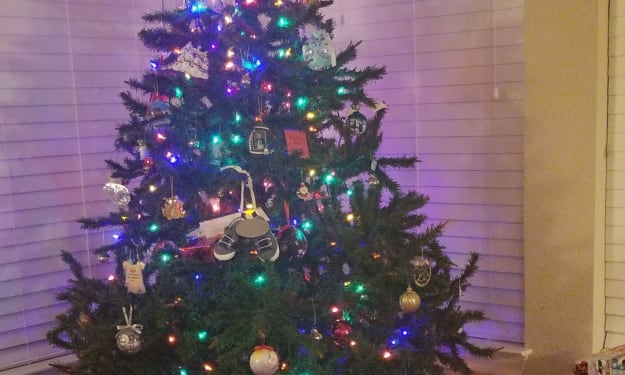What Really Goes Into Writing and Publishing a Song?
I had no idea how to get my music heard.

People ask me all the time, "How did you get music on Spotify/iTunes? Did you make all the beats and stuff yourself? Is that really you singing, cause it sounds so different from your regular voice!" Or my personal favorite, "Wow, you sang that really good! Who is the original artist?"
Now, I love to talk about my music making process. It is my passion after all. So, I figured I'd write to you about how it all goes down behind the scenes, in case you, too, ever have these types of questions. Or, in case you want a quick guide to all you need to know in case you want to start getting your music out there as well!
In the beginning, when I first started writing music, I knew that I was a newbie. I knew that even though I was excited about actually creating a song for the first time from scratch, that the sound probably wasn't as good as I believed it was. After all, a monkey in the eyes of its mother is a gazelle. Not to say it was bad, not at all, I still enjoy going back and listening to my beginning stuff sometimes to compare to how far I've come since then. But my earlier stuff didn't sound radio worthy. I didn't have any idea how to get rid of that fuzzy sound that would creep up in the background of my vocal recordings. Or how many background instruments and how much harmonization was too much or too little to sound full enough or not too crowded. I was still learning! Listening to my favorite songs on the radio, and making covers so that I knew how much work should actually go into making my own songs. Also, I had no idea how to get my music heard, once I did create something that I thought should be appreciated by others. And I didn't want to pay to have it put on the radio if it wasn't as good as I personally thought it was.
So all that being said, it's time for my Singer-Songwriter beginners to do list.
1. Decide what kind of music you want to make.
Not that you can't spread your music making abilities across the musical spectrum. By all means, make as many different genres of songs as your blessed little heart desires! But you do have to start somewhere. So pick a genre, or make up your own combination for your first sound. Listen to different songs in your chosen genre and maybe even make a cover or two, to see how it feels, what kind of sounds, similar tempos, and special effects that go into that specific type of song.
2. Find your instruments, and your vocals (if applicable).
In order to make a song, you need some sounds. Shocking, I know. For me, Apple's GarageBand sort of chose me, being it was the cheapest and easiest to get to at that point in my life. But there are so many options, including the more authentic, as well as expensive real instruments or sound pads. You could even start a band! Just make sure you find a good garage or a place you can practice in peace. So if you want to find real instruments and people to play them, and feel that it will make you a better artist for it, go for it. Where there's a will, there's a way, and can you really put a price tag on dreams? Also, if you want vocals, and don't want to sing yourself, find a friend or post an ad for auditions. There are lots of people out there that love to sing and don't want to or don't know how to go about writing their own music.
3. Create a beat.
Many musicians argue good heartedly with each other about which instrument or sound is the most important part of a song. Depending on which instrument they play, the importance of each instrument changes. However, successful songs usually all have one thing in common: They have a percussion section playing some kind of cadence, which sets the overall tempo of the song. So, with your new found instrumental device mentioned in the previous step, experiment with the different types of sounds and combinations to make the beat for your song. Don't forget to use a metronome to keep the tempo for you while you are recording or practicing!
4. Bring in the band!
So, of course, using the instruments or band members you found in step 2, it's time to add their part to this masterpiece. So have your drummer play the cadence or have it recorded so you can listen to it a couple times while you play different sounds, adding one instrument at a time, to see how different sounds or chords would go along in a way that is pleasant to the ears, and then either write down the chords/notes or record it so that it is not forgotten easily! (Side note: record some of your music sessions if you are making music with a band, for possible future documentaries or promos for your band's music.) Same goes for the vocalist, and it's usually best to add the lyrics last, in case the key or tempo changes in any part of the song while still writing it, so that the lyrics will flow easier and won't need to be tampered with or changed too often.
5. Record that shtuff!
It's not a typo. Now that you and your potential band members (or your electronic music) have a song put together, it's time to record it in a professional sounding manner. Again, I use GarageBand to keep track of all my recordings. But you definitely need some type of microphone with condensing abilities and/or a room that doesn't have too many other sounds, if any, so that you can get the clearest recording out of your sessions. If you have the means, I suggest purchasing a microphone set up that does this for you, or even paying for sessions at a local recording studio. If not, I did start out by using the microphone attached to my iPhone headphones in the beginning and just adjusted the compression settings in GarageBand. Do what you can.
6. Get your music out there.
For bands, it is fairly easy to research local venues to put yourselves out there and perform your new songs. In that case, make sure you throw in some covers of popular songs, maybe change up the melody of the songs to match your style of music, but still allow the crowd to sing along. For electronic artists, it's slightly more difficult to find ways to get people to hear your sounds. I highly recommend creating a Soundcloud account if you don't already have one. It's free up to a certain amount of minutes to upload your music for free streams, downloads, and comments. Then you can advertise your profile all over your social media or ask your friends/family to help tell people by word of mouth or also posting things about your Soundcloud every once in awhile. As for the more complicated sites that actually pay you for streams or downloads (i.e. Spotify, iTunes, etc...) you will need to pay to have your music uploaded to their sites via a third party organization. There are plenty trustworthy businesses out there, such as CD Baby, or Ditto (which is what I use). You pay to upload and have a release distributed to the stores of your choice, usually costing at least $10 for a single. Then, your music will be posted in those stores on your chosen release date, usually a week later minimum from the day you uploaded the music.
So there you have it! All the basic steps to go through in order to create and distribute your music, so that people all over the world can discover and appreciate something that you created. And of course, you will need to take time to do some self promoting and maybe even pay to have promote your posts about your music on social media. But once you see all the people engaging in your music and posts about your music, there really is no greater feeling for a beginner music artist.
About the Creator
Yasmina Sea
American girl who has a little knowledge on a lot of subjects. I like to spread the wealth.






Comments
There are no comments for this story
Be the first to respond and start the conversation.